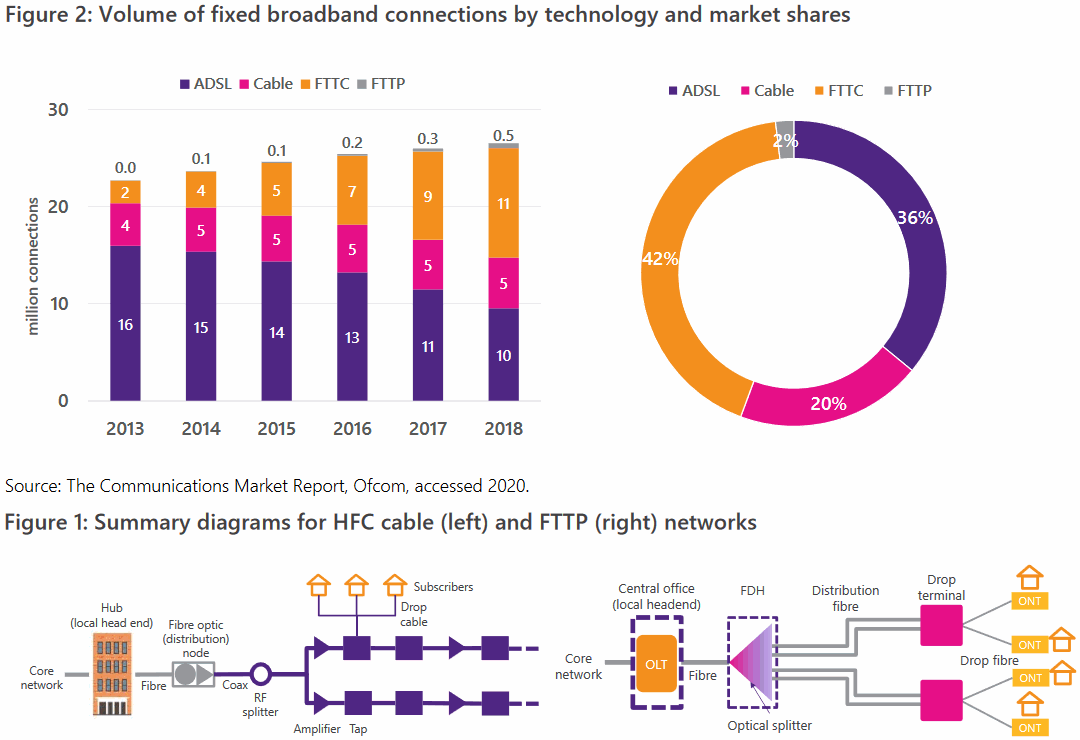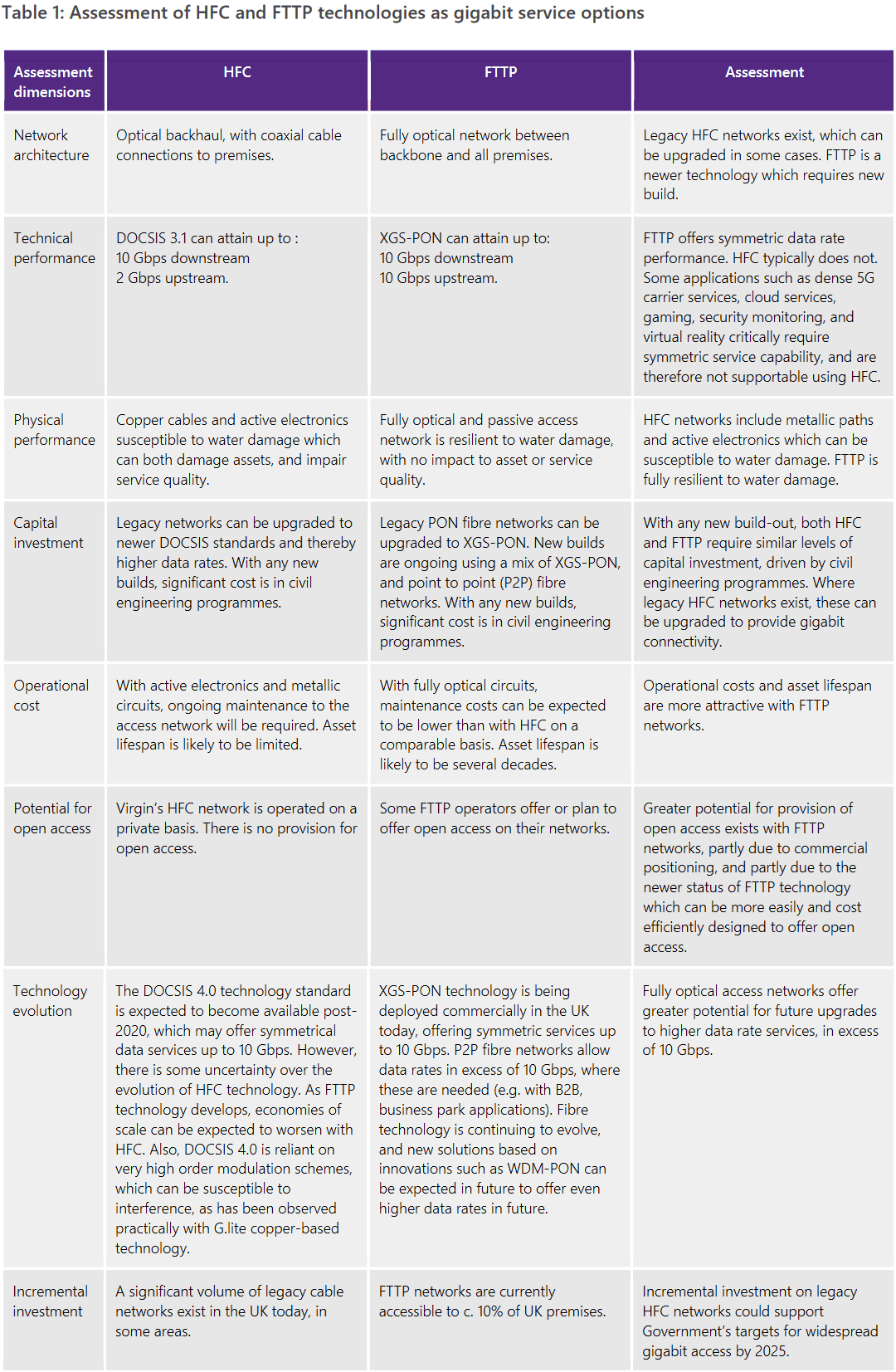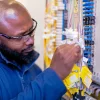Plum Examine the Gigabit Broadband Question of HFC vs FTTP

A new paper from Plum Consulting, which was commissioned by Cityfibre, has assessed the viability of using both Hybrid Fibre Coax (HFC – Virgin Media) and Fibre-to-the-Premises (FTTP) based networks to achieve the UK Government’s aim of bringing “gigabit-capable broadband” to every home by 2025.
As we’ve discussed before (here), the main advantage of the Government’s decision to adopt “gigabit” (1000Mbps+) terminology instead of one based around a pure “full fibre” mentality is that it enables them to be more technology neutral. As a result their 2025 target is now more viable than if it were entirely fibre focused (there’s simply no way they were every going to hit 100% FTTP by 2025), albeit still extremely challenging to achieve.

The primary reason for this is because Virgin Media’s HFC (cable) network already covers roughly half of all premises and it’s in the process of being upgraded to DOCSIS 3.1 technology by 2021 (here), which is making download speeds of 1Gbps+ possible. Sadly upstream performance remains very limited on HFC and is currently just 52Mbps on the new tier, but we’d expect 100Mbps to surface further down the road.
Advertisement
Overall the paper says broadly what we’d expect it to say, which is that HFC networks can and will help to achieve the Government’s target. On the other hand it warns that HFC performance may struggle to keep up with FTTP further down the road.

We should point out that the above table considers a future upgrade to full duplex DOCSIS 4.0 technology, which it rightly notes could be problematic. Unlike the upgrade to DOCSIS 3.1, any move to 4.0 would be a major and very costly upgrade for Virgin Media to undertake (i.e. digging fibre nearer to homes and the replacement of splitters, isolators etc.). Generally speaking we wouldn’t expect them to be contemplating this for a long time (if ever – an upgrade to pure FTTP is another option, albeit also a costly one).
The report does however overlook Liberty Global’s (parent of Virgin Media) tentative proposals to launch Liberty Networks in the UK (here), which seems likely to both build more FTTP into increasingly challenging areas (i.e. the other 8-10 million premises) and to potentially open up Virgin’s existing HFC network to wholesale by other ISPs (e.g. Sky Broadband).
Advertisement
Plum’s paper also briefly touches on the possibility of 5G and Fixed Wireless Access (FWA) based broadband networks being used to deliver gigabit capability, although its assessment on that front is very limited because that was not the focus of this paper.
Plum’s Conclusion
Broadly, we see investment in FTTP as the “better” option for public or gap funded investment, providing a more resilient, “future-proof”, and economically efficient solution (importantly inclusive of ability to support symmetric gigabit data services), supporting open access and thereby effective market competition.
However, where legacy cable networks exist, we believe that there is some value in exploiting these with some incremental investment, which could provide evolution from legacy cable technologies to the newer DOCSIS 3.1 standards and above.
Other technologies such as fixed wireless access (FWA) (whether using cellular 4G or 5G, or dedicated FWA solutions) should not be discounted, and different areas of the UK may well require different technology solutions, if Government targets are to be met efficiently.
With some concerns over the resilience of HFC technology and ability to effectively support competitive access, we conclude that an effective approach will include leverage of HFC networks, where these can be efficiently upgraded (rather than further built out) and used to provide gigabit services. Inclusion of premises addressed by HFC technology will enable Government targets to be met more effectively in the near term.
However, FTTP technology should be deployed in areas where HFC is not available, which, practically, means all areas where new gigabit-capable network must be built (and can be deployed with reasonable cost efficiency). In areas where FTTP is not cost-efficient, and legacy HFC is not available, innovative solutions such as FWA or hybrid fibre-wireless networks should be considered.
In the longer term, FTTP should be built out comprehensively in the UK, as a resilient and future-proof long-term solution, supporting the nation’s digital services economy.
You can download the otherwise fairly short report online (here).
Mark is a professional technology writer, IT consultant and computer engineer from Dorset (England), he also founded ISPreview in 1999 and enjoys analysing the latest telecoms and broadband developments. Find me on X (Twitter), Mastodon, Facebook, BlueSky, Threads.net and Linkedin.
« Ofcom Warns Major UK Broadband ISPs Over Charging for Email
Openreach Test XGS-PON Ahead of Symmetric FTTP Speed Trial »






















































It said what Cityfibre wanted to hear, no surprise. All new VM is fibre duct to the premises.
It is yes, our area was finally expanded into for Virgin and we have fibre to the premises. I suppose older networks if the customer wants to upgrade their speed, they will have to send an engineer out to replace the cable from the street cabinet to the premises.
Speeds are the same regardless of whether the network is HFC or fibre. So, if you’re on M200 and want M350, you phone and get a new contract for the upgrade.
No doubt sponsored by Cityfibre for the consumption of their investors. Far too premature as we still do not have a clear view of how in detail the Government intend to support rural, semi urban and urban investments. In addition is the long awaited plans within Liberty/VM and simply appears not to acknowledge that any new areas (other than infill) will be Full Fibre.
My view is that there is a significant opportunity for HFC while demand for high Ultra/Giga will remain a small percentage of users.
True for now – but in 5 – 10 years time ….
The Government’s objective is Giga speed availability (does not mention upload) so yes this is about the period upto 2025. The national infrastructure objective of full fibre remains 2033ish. HFC could remain very competitive well beyond 2015 and capacity can be increased providing Liberty a window to rollout FTTP if they choose to. Much depends on Liberty’s plans.
2025
With VM’s cable network, what’s the maximum number of properties which could be sharing the same feed from the distribution node?
If Openreach and Cityfibre FTTP have a limit of 32 properties per OLT port, that puts an upper bound on the amount of contention.
Thousands. As many as RF signal power and quality permit.
OLT ports can service 128 properties by the way, if optical power budgets permit.
Openreach seem to work to 30 properties split from a single fibre. An advantage over VM and co-ax is they can run XGS-PON over the same fibre whilst it still supports GPON for all existing customers. So we have 10Gbps plus 2.5Gbps over fibre already between 30 premises and so it is a much better network from the get-go than the co-ax system VM employ, which essentially is a dated cable TV system hacked for broadband.
Fibre has to be the way, if we stick with lots of co-ax as VM use then we will end up ridding ourselves of POTS (plain old telephone system) just to end with POCs (plain old coax system)to be a bottle neck of the future.
@ Phil
I agree that FTTP is way better than HFC.
But I’d also be pretty clear the HFC3.1 is better than VDSL.
Upgrading HFC to 3.1 is useful as a stepping stone but unless VM upgrade the upstream they will get hammered, in the long term, by anyone who can offer and symmetrical is required.
That is for the market to decide.
Loving this, all while in Australia the current government overwrote the previously governments efforts to lay FTTP to 98% of people. The current government says no one needs 100mbps let alone 1000 and rolled out FTTN guaranteeing Australians 25mpbs and final figures due to complications with upgrading the current HFC network along with FTTN having a much higher error rate has cost us billions more, not to mention soon having to upgrade anyway.
What a joke
On a more positive note BT/OR do have Fibre First and the Alt Nets are doing well – so there is a lot of real FTTP that is increasingly available and the pace is getting quite impressive now.
I agree HFC does have its limitations but re-farming existing tech does have a short term benefit. And the benefit of costs and speed. In this case Liberty/VM are not setting their ambitions to get the general estate to 3.1 standard to that 1000/50 is reality and some 1000/100 is possible with some more work.
Liberty/VM also do have sections of the network that are essentially full fibre (OK apart from the last bit thru the wall) so these can either be forked to pure FTTP or allow higher bandwidths over RFoG
Can’t type
In this case Liberty/VM are setting their ambitions to get the general estate to 3.1 standard so that 1000/50 is reality and some 1000/100 is possible with some more work. I agree the NBN spec was not very forward thinking.
This is all very well and good for their purposes. But I wonder how good just relying on one of Virgin or Openreach will so for consumers – both on a competitiveness rate, and on a basic technological level.
Cable has always had a significantly higher latency for me, despite the higher bandwidth.
I’m not entirely convinced adding more channels will improve that – and with things like game streaming becoming more popular, and future applications likely to rely on increased interactivity, I wouldn’t want to be one of those stuck on an outdated technology.
Nor do I think two companies trying to sell me the same cable will result in a huge gain in competitiveness. It would help a lot/more to have actual fibre in the mix as an option (and vcee versa for other locations).
Agreed the latency seems to be higher on HFC.
The devil will be in the detail. Are there different backhaul arrangements for the different resellers of the HFC network? As there are for the OR network with different headend/links purchased. If the whole thing is, as is, all the way I agree there won’t be a lot of service variability. However, I do think that having 3rd parties on the network will drive focus to reducing congestion and contention and generally improving backhaul as others will refuse to resell in areas where it is bad.
It will be interesting but I don’t think that HFC now is the silver bullet it could have been. If VM had gone all 3.1 a while back then it might have had a very different range of impacts – but it didn’t. It is a story of underinvestment and underestimating the pace of change and political focus OR very nearly got caught by this but seem to have, just, dodged the trap. FTTP is very investable ATM and as VM is dominantly urban and FTTP investment is dominantly urban there will be a lot of overlap = people voting with their feet. It will be interesting to see how this plays out.